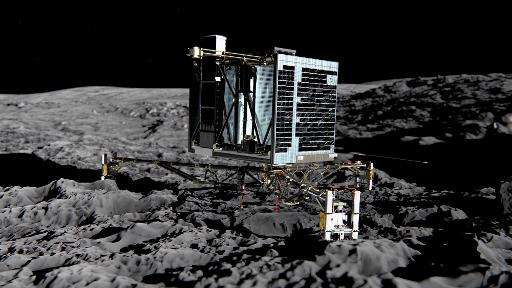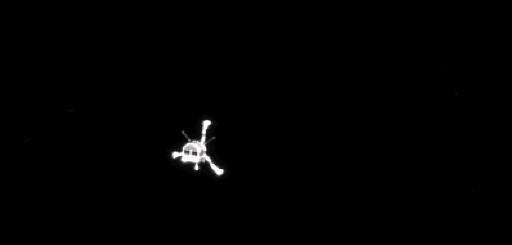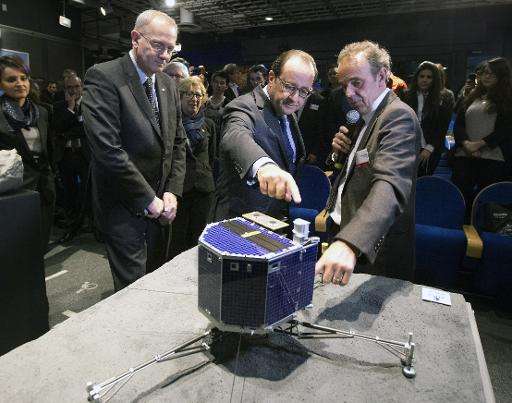'Hello Earth!': Comet probe Philae wakes up

The European space probe Philae woke up overnight after nearly seven months in hibernation as it hurtled towards the Sun on the back of a comet, mission control said Sunday.
The tiny robot lab may be ready to resume science work, adding a fresh chapter to its extraordinary voyage, excited officials said.
"Hello Earth! Can you hear me?" the washing machine-sized lander tweeted under the hashtag #WakeUpPhilae.
"We got a two-minute... successful communication" at 2228 Central European Time (2028 GMT) on Saturday, mission manager Patrick Martin told AFP from the operations centre in Madrid.
"This was sufficient to confirm that Philae is healthy and that its sub-systems are OK in terms of energy and temperature for ongoing communication with Rosetta," he said, referring to the lander's mothership orbiting Comet 67P/Churyumov-Gerasimenko.
The mission seeks to unlock the long-held secrets of comets—primordial clusters of ice and dust that scientists believe may reveal how the Solar System was formed.
The 100-kilogramme (220-pound) robot lab touched down on "67P" on November 12 after an epic 10-year trek piggybacking on Rosetta.
But instead of harpooning itself onto the dusty iceball's surface, Philae bounced several times before settling at an angle in a dark ditch.
It had enough stored battery power for about 60 hours of experiments, enabling it to send home reams of data before going into standby mode on November 15.
As "67P" drew closer to the Sun, scientists hoped better light would recharge Philae's batteries enough for it to reboot, then make contact, and ultimately carry out a new series of experiments.

After two failed bids to make contact in March and April, a new attempt was launched in May.
"We were surprised, yes, because we didn't expect it at all last night, on a weekend—it's really exciting," Martin said.
An ESA statement said Philae communicated with its ground team for 85 seconds, and preliminary analysis of the data showed it must also have been awake earlier but unable to make contact.
'Still a bit tired'
According to Martin, the lander's temperature was about minus 36 degrees Celsius (-29 Fahrenheit) and its energy at 24 watts—both higher than the minus 45 C and 19 watts required to operate.
"Philae is doing very well," said Stephan Ulamec, Philae project manager with the German space agency DLR. "The lander is ready for operations."
Martin was more cautious, saying: "We have already lined up more communication windows which hopefully will see a repeat of this successful communication.
"If we get a stable communications pattern we should be able within a week or so to think about operating the instruments on board the lander."

A tweet in the name of Rosetta announced: "Incredible news! My lander Philae is awake!", before prompting the robot to "take it easy for now" while checks are run to see that it is "fit, healthy and warm enough".
This prompted a Twitter response from Philae: "Oh, OK... I'm still a bit tired anyway... talk to you later!"
NASA tweeted "Rise and shine!" while Britain's usually staid Royal Observatory shouted: "YES!!!"
The comet and its precious cargo are 215 million kilometres (134 million miles) from the Sun and 305 million km from Earth, racing at a speed of 31.24 km a second, according to ESA's website.

Rosetta and Philae have travelled an accumulated distance of 6.9 billion km.
By August 13 the comet will reach its closest point to the Sun, or perihelion, before veering off again into the deeper reaches of space.
There are still more than 8,000 data packets in Philae's mass memory to be analysed, according to ESA.
Philae's operators hope that the new data will allow them to pinpoint the lab's exact location on the comet, which has so far been narrowed to an area of about 100-200 metres (328-656 feet).
Timeline of Europe's comet-chasing Rosetta mission
A timeline of Europe's comet-chasing Rosetta mission, whose lander, Philae, has woken up after spending nearly seven months in hibernation on Comet 67P/Churyumov-Gerasimenko.
- March 2, 2004: Liftoff from the European Space Agency's launchpad in Kourou, French Guiana by Ariane 5 rocket.
- March 2005: Rosetta encounters the Earth, using the planet's gravity as a slingshot to boost speed. It flies by Mars in 2007 and twice more by Earth, in 2007 and 2009, in order to accelerate further.
- June 2011 to January 20, 2014: At its maximum distance—about 800 million kilometres or 500 million miles—from the Sun and a billion km from home, Rosetta hibernates to conserve energy.
- August 6, 2014: Rosetta arrives at comet "67P", and goes into orbit. It has 11 onboard cameras, radar, microwave, infrared and other sensors to analyse the comet surface and gases escaping from its head.
- November 12, 2014: Rosetta sends down a 100-kilogramme (220-pound) lander, Philae, equipped with 10 instruments. After bouncing several times, Philae ends in a dark but unknown location and does not have enough sunlight to recharge its batteries.
- November 15, 2014: Philae's stored battery power runs out after about 60 hours of work. It sends home reams of data before going into standby mode.
- March to May 2015: Mission controllers make three attempts to listen out for Philae, hoping increased light and warmth will revive it as "67P" nears the Sun.
- June 13, 2015: Philae emerges from hibernation, and sends home a two-minute message at 2028 GMT.
Looking ahead
- August 13, 2015: Looping around the Sun, "67P" reaches its closest point to the star—a distance of 186 million km (116 million miles).
- December 2015: Scheduled end of mission. Escorted by Rosetta and with Philae on its back, the comet heads out of the inner Solar System. At this point, Rosetta will once again come close to Earth's orbit, more than 4,000 days after its launch.
© 2015 AFP




















